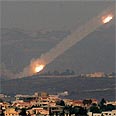
Sunday's attack. Unprecedented diplomatic achievement
צילום: איי פי
No way to stop katyushas
Wise application of ground forces is the only way to win this war
The government and IDF brass made the correct decision not to strike a decisive blow against Lebanon following Suday's katyusha barrage. Such a blow would have given the Lebanese government and Hizbullah cause to reject a proposal by the Security Council, and to blame Israel for it.
Thus, Israel would have lost an opportunity to score official points on the international stage, and would have angered the Bush administration, which is currently pushing the UN to adopt the draft proposal.
When the UN passes a resolution sometime this week, Israel will chalk up an unprecedented diplomatic achievement, and can prepare for continued fighting. Why? Because Hizbullah will not stop fighting in south Lebanon as long as IDF soldiers are there. Therefore, katyusha fire will continue.
Re-definition needed
At best, there will be a partial lull in the fighting. If the government and the army make the most of this opportunity, it could be a turning point for our benefit in this war. We don't need to hit them; we need to make preparations, starting today.
First of all we must clearly re-define the army's operative goals. Clearly, the most serious problem Israel faces at the moment is continued short-range missile fire – katyushas – that has been responsible for most of the death and destruction in Israel over the past 27 days.
The missiles also allow Nasrallah to tell the Muslim world, and the international community in general, that he has not been beaten.
Long-range threat dealt with
The air force has managed, more or less, to deal with long-range missiles. These rockets have occasionally caused great damage, as we saw in Haifa, but in general such attacks are becoming rare.
Therefore, the IDF's central, clear goal now must be to reduce katyusha fire by 90 percent.
The second operational goal is to prevent Hizbullah from re-deploying in south Lebanon before the area is given over to Lebanese army and international force control.
This goal is not simple. In order to achieve it the IDF must establish its presence on the ground, in addition to air-born operations. Not at outposts, but troops that will be in motion all the time. Thus, fewer soldiers will get hurt, and Hizbullah will be forced to get out of this alive, instead of planning attacks.
If these two goals are more-or-less achieved, the IDF will have won this war. The main thing, as noted above, is to curtail further katyusha attacks. In order to do this we must kill every Hizbullah member in south Lebanon and comb every village.
Wise use of ground forces
There is also no need for the IDF to push all the way to the Litani River. IDF soldiers dipping their toes in the Litani will not help bring an end to the rockets. This can be done pointed fire from relatively short-range, by IDF forces who have taken critical vantage points near Hizbullah staging areas.
It's a fact: Missile fire has fallen dramatically in areas the IDF now operates in. This is also true in villages that our troops have only encircled, not entered.
Four regions of fire
Northeast of Metullah: Mount Dov, Rajar, and other villages in the area. Used mainly to fire at Kiryat Shemoneh. The IDF hasn't entered the area in order to forestall Syrian concerns about an IDF attack on its territory.
Nabatean Heights, west of the Litani River. A large area, tough to conquer, but containing more than a fair number of vantage points to pinpoint rocket launchers in real time and to attack them with artillery and air fire.
East of Tyre. This region is being used to fire all types of rockets. The thick brush makes it possible to fire rockets and quickly disapjpear. On the other hand, it is a classic region for invasion forces to operate. Deploying such units and a large number of soldiers near the towns could yield decent results.
"Nature outposts". Launching sites hidden in underground bunkers, covered by thick brush. Some 40 such sites are scattered around south Lebanon, and conquering them will be costly and difficult. But they can be handled with "special treatment" from the air. First, burn down the foliage and the camouflage, then drop a few bunker-busters on the area.
Deploying the correct units and battle plans for each region would be enough to affect a real reduction in the number of missiles fired at Israel. The northern command has long possessed plans to use massive troop presence to reach launch sites, while at the same time dealing with an outflanked border.
Relying on the air force
But the IDF brass, with the air force generals setting the tone, recommended to the defense minister and the cabinet to go after Hizbullah's "tough outer shell" near the border.
Worse: Instead of attacking a variety of targets near the border and deeper into Lebanon, with a massive, varied show of force, they elected to fight head-on and slowly against the steadfast opposition.
That's the way the IDF marched straight in to the trap set by Hizbullah. The cabinet accepted the chief of staff's and defense minister's recommendations because they feared heavy losses, and because going in with heavy ground forces seemed to them a recipe for getting sucked backed into the Lebanese quagmire. Now, it seems there is no other choice.










